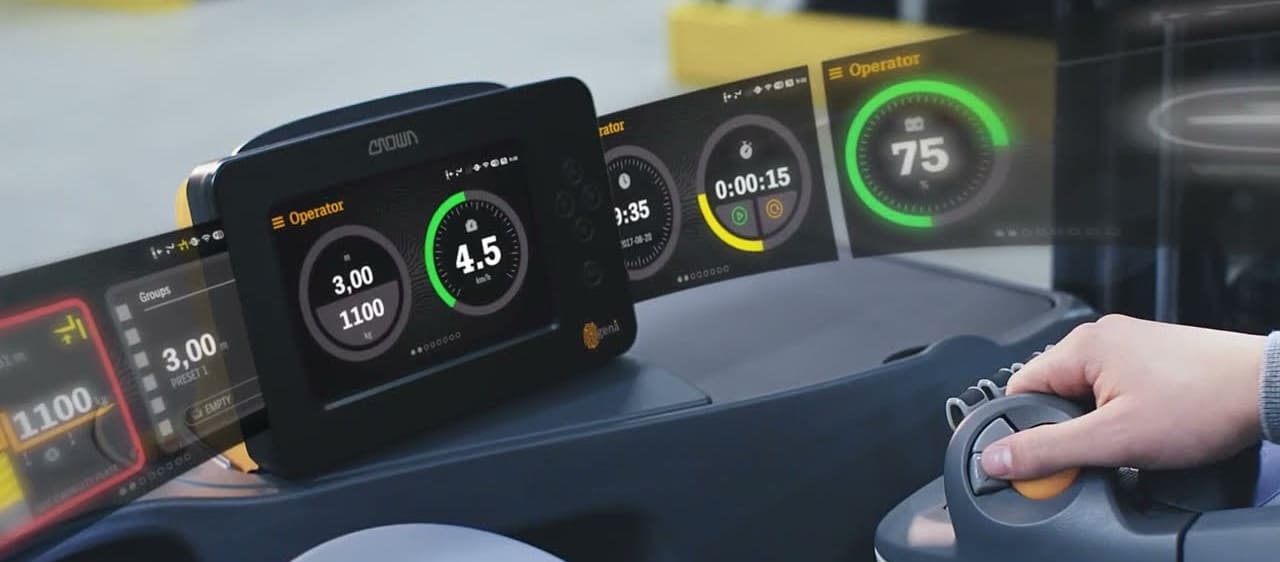
product design for fleet management SaaS and lift truck interfaces
lead interaction designer // design strategy • design vision • design leadership • UX design • UI design • prototyping • visual design • UX research
I led interaction and UI design for Crown’s InfoLink fleet management SaaS and new Gena lift truck interface, developing environment-aware, user-centered solutions for clients like Amazon in partnership with UX researchers, interaction designers, visual designers, engineers and front-end developers. I conducted in-depth design research and participated in extensive qualitative research at multiple warehouses, including becoming lift truck certified, to better understand user needs and pain points.
The groundbreaking Gena truck UI design received an awarded patent for which I'm the primary inventor. A truck featuring the Gena interface won the iF Design Award in 2021.
business goal
As a leader in the lift truck industry, Crown aimed to create a new intelligent warehouse system across their fleet management software and lift trucks. This bold initiative included creating a new GUI truck interface to enhance truck operation and environmental awareness, and a redesigned fleet management SaaS platform that would be able to interface with the truck UIs directly. The goal was to design a system that met the unique needs of operators and managers, while integrating seamlessly with clients' environments and Crown’s existing trucks and SW platform.
user impact goal
The new interfaces needed to provide lift truck operators with an intuitive and efficient interface, reducing training time and operational errors while communicating seamlessly with fleet management software. It needed to address the unique pain points and needs of operators in a warehouse environment, keeping operators engaged but more importantly, safe. My goal for this project was to have as in-depth an understanding of operators and warehouse operation as possible in order to design an ideal solution for both operators and their managers.

design process
01/ research and discovery
I collaborated closely with product managers, engineers, and developers to understand business requirements and technical constraints. In partnership with our research team, I conducted extensive qualitative and ethnographic research, visiting multiple warehouses to observe lift truck operators and gaining firsthand insights into their workflows, pain points, needs and motivations. This included becaming certified as a lift truck operator, allowing me to deepen my understanding of the experience of operating a truck in a warehouse, and the uniquechallenges operators face on a daily basis.
02/ definition and exploration
Using insights from research, I led the design team in developing an intuitive and user-centered UI solution for the lift truck interfaces. I hosted multiple design sessions where we combed through qualitative and quantitative research findings to uncover the mental models and needs of operators. Through that research, I designed a scalable interface that could adapt to the diverse needs of individual warehouse operators. The design balanced glanceability with engagement, ensuring a seamless and safe experience for operators, tailored to each user's needs.
03/ validation and iteration
In addition to upfront research, the UI and SaaS experiences were validated through multiple rounds of user testing, focusing on both lift truck operators and warehouse managers. Feedback from these sessions led to key refinements in the interface, improving usability and streamlining workflows. Prototypes were iterated upon in collaboration with engineers to ensure that the final product met technical requirements and user needs. Most importantly, direct operator feedback from user testing and ethnography greatly influenced the final design, especially in terms of simplifying interactions and improving overall ease of use.
04/ delivery and implementation
Documentation of the UI design was created in direct collaboration with development to ensure the UI was implemented as envisioned. This included providing detailed design specs for development as well as frequent, hands-on reviews of the developed solution as it was being built. We collaborated on addressing technical constraints and refining the design to ensure seamless integration with the truck hardware and fleet management system. The final solution was successfully deployed across Crown’s lift trucks, improving operator efficiency and safety.






